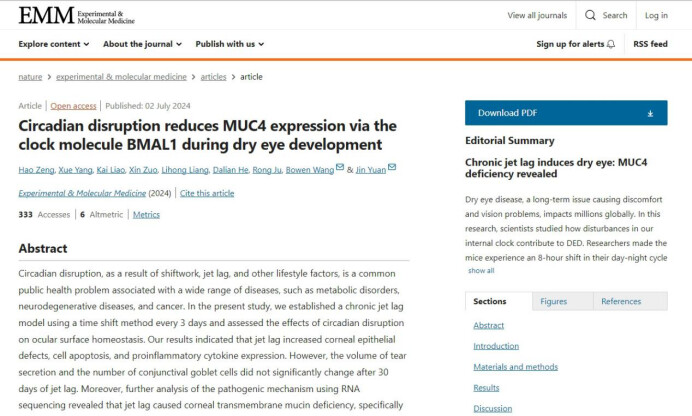The research team at the Zhongshan Ophthalmic Center (ZOC) of Sun Yat-sen University recently published a study disclosing the molecular pathogenesis of dry eye related to circadian disruption, and found that melatonin helps restore circadian disruption and alleviate ocular surface damage. The findings were published in the journal Experimental & Molecular Medicine.

(Screenshot from the journal Experimental & Molecular Medicine.)
In recent years, lifestyle-related dry eye disease (DED) has been gaining increasing attention. Professor Yuan Jin, the leader of the research team and deputy director of ZOC, said that previous clinical studies found that tear film instability increases among night shift workers, leading to a higher risk of dry eye. Circadian disruption, a common type of sleep disorder, is frequently observed in populations including night shift workers. However, the mechanism, clinical characteristics, and effective intervention measures for circadian disruption-related dry eye have not been clearly elucidated.
The research team constructed a mouse model with circadian disruption by altering light-dark cycles to simulate chronic jet lag responses. They discovered that mice with circadian disruption showed signs of dry eye, with their ocular surface lacking mucin. Analysis confirmed a significant decrease in transmembrane mucin MUC4 in the cornea.
The core mechanism of circadian disruption is the disruption of the molecular clock, with the BMAL1 gene serving as the core activating factor. The study found that the expression of the BMAL1 gene in the corneas of mice with circadian disruption significantly decreased. In mice with the BMAL1 knockout, a significant decrease in MUC4 expression was observed, along with characteristic ocular surface damage, which confirmed the regulatory role of the BMAL1 gene on corneal transmembrane mucin MUC4 expression.
Furthermore, the study discovered a significant decrease in serum melatonin levels in mice with circadian disruption. By supplementing these mice with melatonin, the research team found that it stabilized the systemic and local rhythms of mice with circadian disruption, restored corneal BMAL1 gene and transmembrane mucin MUC4 expression, and rebuilt tear film function and ocular surface homeostasis.
Author | Hannah
Editor | Nan, Abby, James
















